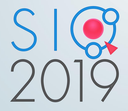Executive Secretary

7th International Chemistry Symposium
SIQ 2019
Abstract
Human activity and population growth have led to the increase of pollutants in surface waters. Among the main contaminants are the pharmaceutically active compounds (PhACs). These have been detected in effluents from wastewater treatment plants (WWTP), demonstrating resistance to elimination by conventional treatments. In this way, toxic concentrations of these pharmaceutical compounds can reach the bodies of fresh water and domestic networks and cause harmful effects on human health and aquatic species (1). The membrane filtration processes stand out as promising alternatives for the final water quality, easy operation, low costs and less space required. The polysulfone membranes (PSU) have been used in microfiltration and ultrafiltration processes due to their physical-chemical resistance and thermal stability. However, its main disadvantage is fouling of the membrane due to its hydrophobic nature, which decreases the permeate flow over time. To counteract this problem, additives are incorporated in the membrane to improve its hydrophilic character (2). The objective of this work is to study the effect of the presence and concentration levels of PSU, polyvinylpyrrolidone (PVP) and polyethylene glycol (PEG) on the hydrophilic characteristics of the membranes. The influence of the molecular weight of the PVP and PEG additives separately on the performance of the membranes will also be evaluated. In the future, the incorporation into the membrane of chelating chemical compounds will be evaluated for the removal of different compounds, particularly antibiotics, in waters for domestic consumption.
Resumen
Human activity and population growth have led to the increase of pollutants in surface waters. Among the main contaminants are the pharmaceutically active compounds (PhACs). These have been detected in effluents from wastewater treatment plants (WWTP), demonstrating resistance to elimination by conventional treatments. In this way, toxic concentrations of these pharmaceutical compounds can reach the bodies of fresh water and domestic networks and cause harmful effects on human health and aquatic species (1). The membrane filtration processes stand out as promising alternatives for the final water quality, easy operation, low costs and less space required. The polysulfone membranes (PSU) have been used in microfiltration and ultrafiltration processes due to their physical-chemical resistance and thermal stability. However, its main disadvantage is fouling of the membrane due to its hydrophobic nature, which decreases the permeate flow over time. To counteract this problem, additives are incorporated in the membrane to improve its hydrophilic character (2). The objective of this work is to study the effect of the presence and concentration levels of PSU, polyvinylpyrrolidone (PVP) and polyethylene glycol (PEG) on the hydrophilic characteristics of the membranes. The influence of the molecular weight of the PVP and PEG additives separately on the performance of the membranes will also be evaluated. In the future, the incorporation into the membrane of chelating chemical compounds will be evaluated for the removal of different compounds, particularly antibiotics, in waters for domestic consumption.
About The Speaker

Prof. Célia Amorim






